
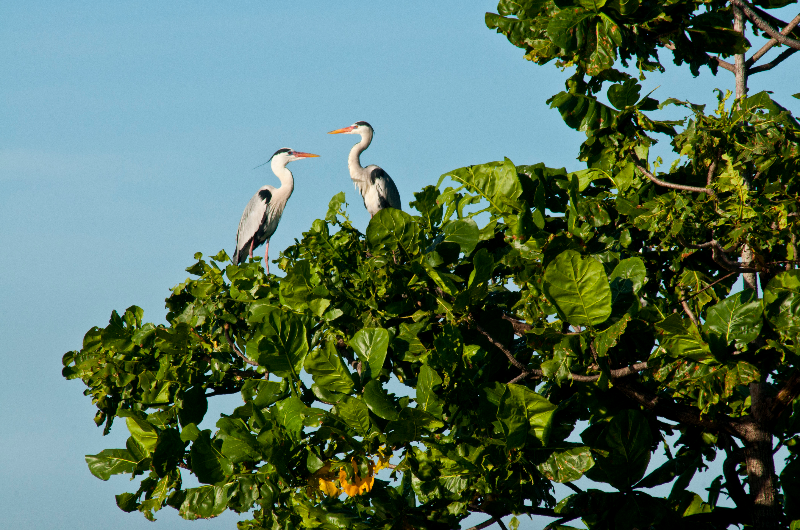
UTAR Bird Sanctuary

Surrounded by 25 scenic lakes, UTAR Kampar Campus is an avifauna hotspot that attracts scores of nature lovers and bird watchers. Interestingly, one of the lakes located at the entrance of the Kampar Campus is a haven for a variety species of migrating birds. Fondly named as the UTAR Bird Sanctuary, one would find a heronry located on an islet in the middle of the lake. The heronry is a location where heron species breed in colony, which itself is an uncommon sight in the country, as special conditions are required to attract the herons to select the location as a heronry. The most important factor is that the birds must feel safe at the location.
A study has indicated that five species of herons are breeding in this heronry, which includes the Grey Heron and Purple Heron as well as other smaller species such as the. Black-crowned Night Heron, Little Egret and Cattle Egret. Besides these breeding birds, within the last five years, the campus is also surveyed to have an impressive count of more than 100 species of birds including large wild birds.
Many species may be very rare with accidental occurrence only, including a recent discovery of a rare migrant, the Himalayan Cuckoo. Some of the species that can be found in UTAR are uncommon in the country but are regularly found in some locations in UTAR, including the smallest wild duck in the country, the Cotton Pygmy Goose. Others include the elusive Pheasant-tailed Jacana, the shy and secretive Greater Painted snipe, as well as the near-threatened species, the Grey-headed Fish Eagle, Black-bellied Malkoha and Long-tailed Parakeet, which are sought after by birdwatchers across the nation.
An annual survey conducted since 2010 indicated that there was a peak of 57 active nests with 298 herons located on the Bird Sanctuary island for the five heron species, not including those that were nesting in the middle of the heronry that were not visible. According to a Waterbird Census conducted in January 2010, the UTAR Bird Sanctuary is likely the second largest active heronry in the state of Perak, after the nation's largest heronry that is located in the nearby Kinta Nature Park, Batu Gajah.
During peak migratory seasons, at least a few thousands of herons from various species would be seen flying across the skies with groups following one and another during the early mornings and late evenings. This is a scenic sight that is not seen in any other university campus in the nation, which makes UTAR unique when it comes to the natural environment of the campus.


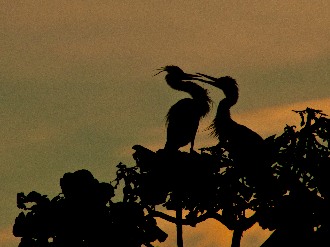

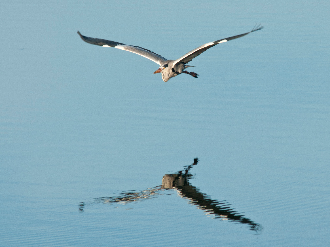
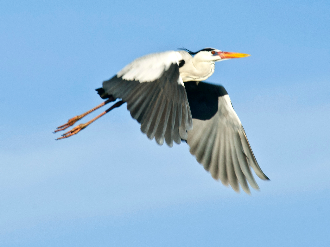



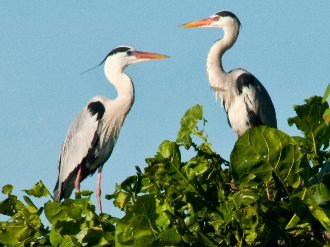

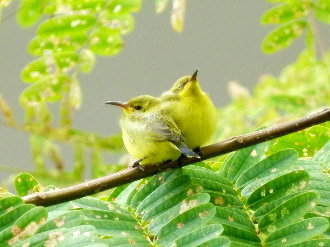
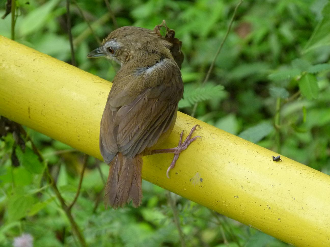
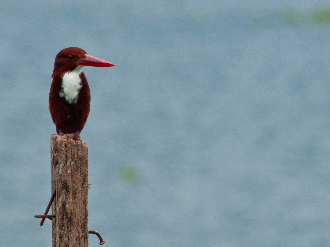
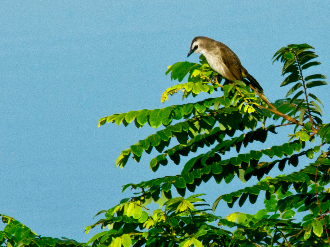

Students and lecturers enjoying the birding experience.
List
of bird species in the campus locality:
- Grey Heron (Ardea
cinerea)
- Purple
Heron (Ardea purpurea)
- Little
Heron (Butoridea striatus)
- Chinese
Pond Heron (Ardeola bacchus)
- Cattle
Egret (Bubulcus ibis)
- Great
Egret (Casmerodius alba)
- Intermediate
Egret (Mesophoyx intermedia)
- Little
Egret (Egretta garzetta)
- Black-crowned
Night Heron (Nycticorax nycticorax)
- Yellow
Bittern (Ixobrychus sinensis)
- Cinnamon
Bittern (Ixobrychus cinnamomeus)
- Lesser
Treeduck (Dendrocygna javanica)
- Cotton
Pygmy Goose (Nettapus coromandelianus)
- Black
Baza (Aviceda leuphotes)
- Oriental
Honey Buzzard (Pernis ptilorhynchus)
- Brahminy
Kite (Haliastur indus)
- White-bellied
Sea Eagle (Haliaeetus leucogaster)
- Crested
Serpent-Eagle (Spilornis cheela)
- Japanese
Sparrowhawk (Accipiter gularis)
- Red
Junglefowl (Gallus gallus)
- Barred
Buttonquail (Turnix suscicator)
- White-breasted
Waterhen (Amaurornis phenicurus)
- Watercock
(Gallicrex cinerea)
- Purple
Swamphen (Porphyrio porphyrio)
- Common
Moorhen (Gallinula chloropus)
- Pheasant-tailed
Jacana (Hydrophasianus chirurgus)
- Greater
Paintedsnipe (Rostratula benghalensis)
- Red-wattled
Lapwing (Vanellus indicus)
- Pacific
Golden Plover (Pluvialis fulva)
- Common
Greenshank (Tringa nebularia)
- Wood
Sandpiper (Tringa glareola)
- Common
Sandpiper (Actitis hypoleucos)
- Pintail
Snipe (Gallinago stenura)
- Oriental
Pratincole (Glareola maldivarum)
- Pink-necked
Green Pigeon (Treron vernans)
- Rock
Pigeon (Columba livia)
- Spotted
Dove (Streptopelia chinensis)
- Peaceful
Dove (Geopelia striata)
- Green-winged
Pigeon (Chalcophaps indica)
- Chestnut-winged
Cuckoo (Clamator coromandus)
- Banded
Bay Cuckoo (Cacomantis sonnerati)
- Plaintive
Cuckoo (Cacomantis merulinus)
- Little
Bronze Cuckoo (Chrysococcyx minutillus)
- Asian
Koel (Eudynamys scolopacea)
- Green-billed
Malkoha (Phaenicophaeps tristis)
- Lesser
Coucal (Centropus bengalensis)
- Large-tailed
Nightjar (Caprimulgus macrurus)
- Savanna
Nightjar (Caprimulgus affinis)
- Germain’s
Swiftlet (Aerodramus germani)
- Glossy
Swiftlet (Collocalia esculenta)
- House
Swift (Apus affinis)
- Blue-eared
Kingfisher (Alcedo meninting)
- Stork-billed
Kingfisher (Pelargopsis capensis)
- White-throated
Kingfisher (Halcyon smyrnensis)
- Blue-tailed
Bee-eater (Merops phillipensis)
- Blue-throated
Bee-eater (Merops viridis)
- Lineated
Barbet (Megalaima lineata)
- Coppersmith
Barbet (Megalaima haemacephala)
- Common
Flameback (Dinopium javanense)
- Rufous
Woodpecker (Micropternus brachyurus)
- Pacific
Swallow (Hirundo tahitica)
- Barn
Swallow (Hirundo rustica)
- Red-rumped
Swallow (Cecropis daurica)
- Striated
Swallow (Cecropis striata)
- Pied
Triller (Lalage nigra)
- Ashy
Minivet (Pericrocotus divaricatus)
- Common
Iora (Aegithina tiphia)
- Yellow-vented
Bulbul (Yellow-vented Bulbul)
- Greater
Racket-tailed Drongo (Dicrurus paradiseus)
- Black-naped
Oriole (Oriolus chinensis)
- Large-billed
Crow (Corvus macrorhynchos)
- Abbott’s
Babbler (Malacocincla abbotti)
- Oriental
Magpie Robin (Copsychus saularis)
- Golden-bellied
Gerygone (Gerygone sulphurea)
- Arctic
Warbler (Phylloscopus borealis)
- Oriental
Reed Warbler (Acrocephalus orientalis)
- Common
Tailorbird (Orthotomus sutorius)
- Ashy
Tailorbird (Orthotomus reficeps)
- Yellow-bellied
Prinia (Prinia falviventris)
- Zitting
Cisticola (Cisticola juncidis)
- Asian
Brown Flycatcher (Muscicapa daurica)
- Pied
Fantail (Rhipidura javanica)
- Forest
Wagtail (Dendronanthus indicus)
- Grey
Wagtail (Motacilla cinerea)
- Paddyfield
Pipit (Anthus rufulus)
- Brown
Shrike (Lanius cristatus)
- Long-tailed
Shrike (Lanius schach)
- White-breasted
Wood-swallow (Artamus leucorynchus)
- Philippine
Glossy Starling (Aplonis panayensis)
- Common
Myna (Acridotheres tristis)
- Jungle
Myna (Acridotheres fuscus)
- Brown-throated
Sunbird (Anthreptes malaccensis)
- Olive-backed
Sunbird (Nectarinia jugularis)
- Scarlet-backed
Flowerpecker (Dicaeum cruentatum)
- Baya Weaver (Ploceus philippinus)
- Eurasian
Tree Sparrow (Passer montanus)
- Scaly-breasted
Munia (Lonchura punctulata)
- Chestnut
Munia (Lonchura malacca)
- Little Ringed Plover (Charadrius dubius)
- Common
Redshank (Tringa totanus)
